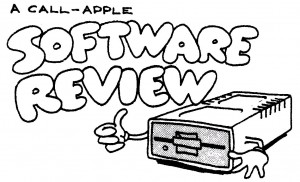By Val J. Golding
APPLESOFT I I Extended Precision Floating Point Basic. $20 from Apple dealers or direct from Apple Computer, 10260 Bandley Drive, Cuptertino, CA 95014. Supplied free with new 16-48K Apples. A ROM version is expected to be released about July 1st for $99.
One’s first impression might be that charging for this updated version of Applesoft is unfair, which was our snap judgement. However, consideration must be given to other facts, the first being that Apple Computer has spent a small fortune in development costs and programlning expense, and through the sale of the cassette tapes is attempting to recoup only a small portion of that expense. Secondly, Applesoft II is so much modified from the original that it should properly be considered as a new Basic, rather than a modification. And on this basis, a search through magazine ads reveals that many computer owners, Altair, Imsai, etc., pay hundreds of dollars for a good extended Basic, still not a “rip-off” price, once again taking development costs into account.
Despite it’s superior string handling capabilities, we have avoided Applesoft I for a number of reasons, including the many format differences from the faster running Integer Basic, and the lack of immediate error messages, owing to the manner in which the two respective Basics are compiled. Many of these items, minor in themselves, such as the use of a hyphen instead of a comma in the LIST command, have been rectified. In contrast, the listing format has also been revised. with the consequence that, like Integer Basic, one must now utilize the POKE 33,33 routine to avoid tracing over the gaps in long print statements.
In addition, it is also necessary to backspace with escape “B” to copy a line number. Apple says this will not be changed. Mores the pity. Applesoft II contains over 35 new or modified commands, in addition to most of the originals. Whenever possible, command names have been changed to match th0se of Integer Basic, a much needed change. The renamed commands are: GR, PLOT, COLOR=, HLIN, VLIN, TEXT, CALL and HTAB. The new commands inc1ude FLASH, INVERSE and NORMAL; TRACE and NOTRACE; STORE and RECALL; ONERRGOTO and RESUME; HOME; POP; SPEED. The latter intrigues us as it provides a means for the first time to control the output speed to either printer or screen, and we have found it most useful in listing programs. We are happy to see the powerful TRACE debug command added, but regret that no room was left to include the handy DSP and AUTO. But then, there is room for only 128 such tokens. (See the Applesoft II token chart elsewhere in this issue. ) In addition to the foregoing, there are about a dozen commands committed to the handling of High Resolution graphics, available for the first time in Applesoft.
Apple has indicated that the random number generator has now been repaired, and that math accuracy has been improved. As is the case with earlier Apple documentation, the eight pages that come with the cassette as a supplement to the Applesoft manual leave something to be desired. A case in point. In our first attempt to use the Applesoft II HIRES routines, we struggled through the list of commands, noted one error and one omission and finally managed to draw some lines on the screen. The colors are still a mystery to us, behaving quite differently in vertical and horizontal modes.
Were this to be used with some of the earlier component-based microcomputer systems we would state that the documentation was adequate, since for the most part users are assumed to have some background in data processing. Such is not the case with Apple II, the forerunner of a new generation of “plug-in-and-run” microcomputers. Hopefully by the time the ROM version is released, Apple will have completely revised the Applesoft Manual.
In all fairness, we must also offer our opinion that in the final analysis, Applesoft II will come to be known as one of the most versatile and powerful extended BASICs available, and we suspect that we will be making a great deal more use of “ASII” than we did of its’ predecessor.














